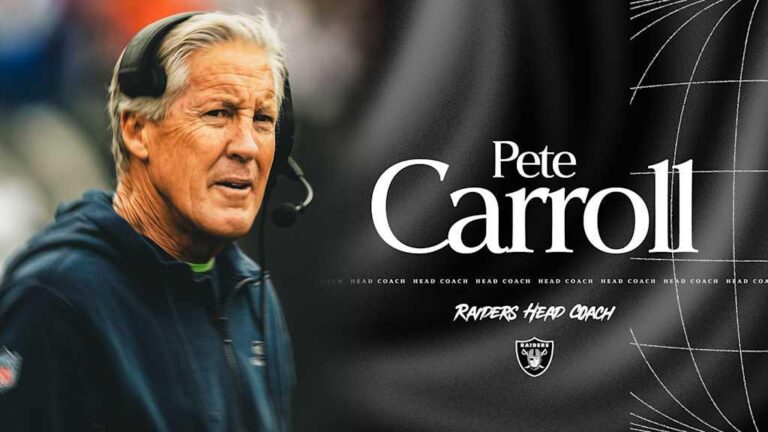Las Vegas Raiders: Evaluating the Path Forward Under Pete CarrollŌĆÖs Leadership
Understanding Pete CarrollŌĆÖs Coaching Style and Its Compatibility with the Raiders
Pete CarrollŌĆÖs coaching ethos centers on building a tenacious, disciplined squad that thrives on player growth and a high-energy defensive mindset.His approach champions a ŌĆ£next man upŌĆØ beliefs, fostering a competitive yet supportive team environment. Carroll values versatility and athleticism over relying solely on star talent, a method that has flourished in franchises focused on gradual cultural progress and steady progress.
However, the RaidersŌĆÖ current roster compositionŌĆömarked by several veteran players and an inconsistent offensive lineŌĆöpresents challenges in fully implementing CarrollŌĆÖs system without important roster changes. Key facets of his strategy include:
- Dynamic, aggressive defense: Demands defenders who are both versatile and physically durable.
- Flexible offensive schemes: Requires rapid decision-making and adaptable playmakers.
- Emphasis on special teams: Leveraging field position to influence game momentum.
| CarrollŌĆÖs System Requirements | Current Raiders Roster Reality |
|---|---|
| Youthful, fast-paced defense | Aging defensive unit with limited depth |
| Quick, adaptable offence | Offensive line struggles and few explosive playmakers |
| Consistent special teams execution | Inconsistent performance in special teams units |
While CarrollŌĆÖs coaching principles are promising, the Raiders may need a thorough roster overhaul to truly harness his systemŌĆÖs potential. Prioritizing youth and cultural transformation could yield better long-term results than expecting immediate success from the current lineup.
Identifying the RaidersŌĆÖ Core Challenges and Growth Opportunities Under Carroll
Despite the excitement surrounding Pete CarrollŌĆÖs arrival, the Raiders face significant hurdles that impede instant progress. Defensive inconsistencies, especially in pass coverage and third-down stops, remain problematic. The offensive lineŌĆÖs inability to provide reliable protection has also hampered offensive rhythm,allowing opposing teams to sustain drives and limit scoring chances.
Nonetheless,CarrollŌĆÖs expertise offers a foundation for improvement. His defensive acumen could stabilize the secondary,and his focus on conditioning might enhance offensive line performance. Key developmental areas include:
- Revamping the defensive backfield: Introducing younger talent and refining coverage strategies.
- Quarterback support: Strengthening pass protection and improving decision-making under pressure.
- Wide receiver adjustments: Tailoring routes to increase yards after catch and overall effectiveness.
| Area | Current Weakness | CarrollŌĆÖs Potential Influence |
|---|---|---|
| Defense | Unreliable pass coverage | Strategic improvements in secondary play |
| Offense | Weak offensive line protection | Enhanced conditioning and blocking techniques |
| Special Teams | Inconsistent kick coverage | Improved discipline and tackling focus |
Why a Full Rebuild Before 2026 Could Be the RaidersŌĆÖ Best Strategy
Opting for a thorough rebuild ahead of the 2026 NFL season could strategically position the Raiders for sustained success rather than short-term fixes. By revamping the roster,Pete CarrollŌĆÖs coaching staff can cultivate a culture centered on growth and adaptabilityŌĆökey traits in todayŌĆÖs NFL,where balancing youthful energy with veteran savvy is essential for prolonged competitiveness.
Key benefits of this approach include:
- Enhanced draft opportunities: Securing multiple early-round picks to fill critical roster needs with high-upside players.
- Salary cap management: Shedding costly contracts to free up resources for targeted free-agent acquisitions that fit CarrollŌĆÖs system.
- Focused player development: Emphasizing rookie integration and tailored training aligned with the teamŌĆÖs refreshed vision.
This method not only allows for calculated risk-taking but also establishes a clear timeline for returning to playoff contention within two to three seasons.
| Advantage | Immediate Effect | Long-Term Benefit |
|---|---|---|
| Draft Capital | More selections, reduced pressure to win now | Robust talent pipeline |
| Cap Flexibility | Lower payroll commitments | Ability to attract key veteran signings |
| Cultural Reset | Adjustment phase | Enduring team identity and cohesion |
Targeted Draft Picks and Free Agent Signings to Expedite the Rebuild
To accelerate the RaidersŌĆÖ transformation, the 2024 NFL Draft should focus on foundational positions that promise long-term impact.Defensive standouts like Edge rusher Sam Williams or cornerback Tariq Thompson could immediately strengthen the pass rush and secondary, addressing critical defensive gaps. On offense, selecting a versatile wide receiver such as Marcus Fields or a reliable offensive lineman like Elijah Turner would enhance protection and offensive versatility around a future franchise quarterback.
Complementing rookies with savvy, budget-conscious free agents is equally vital. The Raiders might pursue seasoned veterans known for leadership and locker room influence, such as linebacker Malik Jefferson or safety Devin McCourty, to bring stability to the defense.Prioritizing experienced role players over costly stars will help maintain cap flexibility while deepening the roster. Below is a comparison of prime free agent targets based on fit and affordability:
| Player | Position | Key Strength | Projected Contract |
|---|---|---|---|
| Malik Jefferson | LB | Pass Rush & Leadership | 2 years / $7M |
| Devin McCourty | S | Coverage & Versatility | 3 years / $15M |
| Jalen Davis | CB | Slot Coverage | 1 year / $2.5M |
| Ryan Jensen | OL | Interior Line Depth | 1 year / $2M |
Final Thoughts: Balancing Immediate Ambitions with Long-Term Vision
As the Las Vegas Raiders chart their course under Pete CarrollŌĆÖs stewardship, the question remains whether to chase quick victories or commit to a full-scale rebuild. CarrollŌĆÖs history of success suggests the possibility of a rapid turnaround, yet the current roster and competitive environment may require patience and deliberate roster construction. Ultimately, the RaidersŌĆÖ front office must weigh short-term goals against sustainable growth, aiming to position the team as a formidable playoff contender by the 2026 NFL season and beyond.




